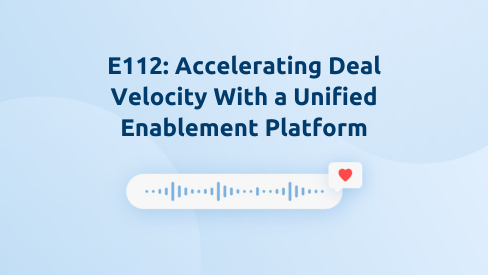According to the State of Sales Enablement Report 2024, organizations that use one unified enablement platform are 80% more likely to increase their win rate. So, how can you optimize your tech stack to improve adoption and drive results?
Shawnna Sumaoang: Hi, and welcome to the Win-Win podcast. I’m your host, Shawnna Sumaoang. Join us as we dive into changing trends in the workplace and how to navigate them successfully.
Here to discuss this topic is Jacob Dinsdale, the sales enablement leader at Molina Healthcare. Thank you for joining us. Jacob. I’d love for you to tell us about yourself, your background, and your role.
Jacob Dinsdale: Thanks. Happy to be here. My background, I’ve been in sales for a long time, a couple of decades now. My sales career started in financial services, working for one of the largest global investment managers. Everything from the trading floor to wealth management moved on the technology side there. Ended up moving into the tech side of sales in general during the.com boom. I was the first sales hire for a European company moving into the United States.
Built that into a large company. So I’ve worked in pretty much all areas of the sales process. Whether it’s carrying a quota as an individual rep, running a team, or running a sales organization full of lots of teams and lots of sales channels.
SS: Well, Jacob, we’re lucky to have you here. Given your extensive sales experience as well as the experience that you have with Molina Healthcare, I’d love to understand from your perspective, what are some of the unique challenges that sales reps in the healthcare industry face, and how can enablement help overcome these?
JD: That’s a great question, and I think that’s one of the things that makes us unique.
For those who aren’t familiar, Molina is one of the largest healthcare organizations in the United States. I think at the last ranking, we are number 1 76 in the Fortune 500. But unless you live in a particular state, you may not be familiar with who they are. Specifically, we handle healthcare for people that are in some sort of a government-sponsored healthcare situation, whether that’s Medicare, Medicaid, or they bought their own individual plan through the Affordable Care Act in the marketplace.
So that’s one of the things that makes us unique and in healthcare as a regulated industry, especially when we’re engaging in government-sponsored sales operations, having. The right and trustworthy material is very important to us. So, you know, all of our agents are, you know, fully licensed in the state and federally.
And then as an organization we have responsibilities there. So making sure that we are only giving correct and timely information in the approved methods, and all of our methodology and communication is compliant with our customers. So with those constraints. We’re somewhat unique and we realized that also created bottlenecks for us.
SS: I see. And you also recently implemented an enablement platform for the first time. What were some of the challenges that your team faced that led you to invest in a solution and, and how have you overcome some of those since implementing an enablement platform?
JD: One of the things that we realized is we had a lot of problems that we solved individually, and that created a lot of different and disparate systems that we use to solve those individual problems. Whether it’s using SharePoint to manage documents, using Salesforce to communicate, using whatever random tool or individual sales organizations might be using to communicate with potential new members.
So, from our standpoint, having one kind of unified location that we can have confidence in the governance of what we’re doing, knowledge about the processes of what we’re doing, control over what can and can’t happen, and that creates confidence for us as an organization. But I think also that lets us move that confidence back to our salespeople who don’t want to really.
Focus on a lot of the details they’d like to be sewing. So if they know that the sandbox that they’re playing in is fully compliant, fully usable for them, then they can take that sandbox and really be free to do what they do best as a salesperson. So, you know, that was kind of our goals, is to try and come up with a unified message in that and having unified tools that all of our organization can use.
SS: I love that. And you played a key role in the implementation of Highspot, so I’d love to learn from you, and I’m sure our audience would as well. What are some of your best practices for driving adoption from the start and really engaging the teams you support in your enablement programs?
JD: You know, and this might come from my background, working in sales to begin with, but one of the things that I always believe is.
Having a destination in mind and working backwards. So when you’re talking about driving revenue and driving sales at a company, ultimately you wanna have that dotted line. You wanna complete a transaction from us as a process, knowing where we want to be, knowing that we want to have strong, rich content that empowers our different sales channels to do really well in what they want.
That lets us. We’re backward to have that and build what we need along the way so we don’t end up building a road to nowhere. We’re building the road to our destination, and I think that was important for us to make sure that defining the route, defining the map, working backwards to where we want to go, helped us get all the stakeholders aligned because anytime there was a disagreement, we could always work backwards to that north star, right? That guiding privilege that we have as an idea we want to get to.
SS: I love that. I always think that it is a fantastic philosophy to start with the end in mind. Now, I know that you guys have seen success in a lot of areas, but I know one of the areas that you’ve seen success in is through the use of digital rooms. I’d love to learn from you. Could you share more about how you’re using digital rooms to optimize workflows for your teams?
JD: Digital Rooms are a great compliment for us in one of our sales channels. So we sell directly. We have our own licensed insurance agents that bring in new members into Molina Healthcare, but in some markets that doesn’t make sense.
And this also exists in the insurance industry in general. There’s a lot of independent brokers, so we have a broker channel sales. Department around the country that works with these independent brokers who are then working with members. They generally work with many different companies, but what we want to be able to do is to make it easy for them to do business with us and to make it easy for them to do business with us is, is having quality content and information on their fingertips.
So if a customer says, hey, is this medication gonna be covered under this new plan? I live in the Bay Area and I practice traditional Chinese medicine and acupuncture. Is that something that’ll be covered under this plan? To be an expert on all of that with the different companies isn’t something an independent broker can do, but we’re able to use these digital rooms as a microsite to have this information that these external brokers can use, but also for us to make sure.
We know that we have the most timely information and we’re seeing some changes in the Center for Medicare and Medicaid with CMS right now and new leadership. That required us having new, updated documentation, what we have there. So we’re always using the current and most approved documentation, but we can also be dynamic in our communication to our sales channels.
SS: I love that. Can you walk me through that a little bit? The strategy in particular for the Digital Rooms, for your broker channel sales partners. How are they structured and delivered and what impact have you seen so far?
JD: They’re structured by our market. So in any particular market, we’re working with various, uh, levels of different health plans and the health plan, we’re going to be providing basic information.
So they’ll have access to, you know, enrollment forms, basic government documentation, but they’ll also have important things like, hey, is my transportation to see the doctor covered? You know, do I get a OTC benefit spent at CVS every quarter, little bits of information and have that in the same location is important.
I think, again, this is something that we’ve seen both with our internal sales channels and our external sales channels, having the buy-in and confidence from the users that know, oh, I don’t know where to find it everywhere, but I know that I can probably find it in Highspot. That gives us a really good ability to get that stickiness from the user base that we wanna see.
SS: I love that. I think that’s fantastic. To pivot a little bit, I know you also plan to utilize AI features in Highspot to elevate your enablement efforts. How do you envision leveraging AI capabilities to improve productivity across the teams you support?
JD: Well, as a mature long-term industry, you know, using AI is something that I think a lot of organizations find scary in including us as well, and knowing where we can or can’t do that.
So from our standpoint, it’s going to be very, very subdued in what we do. But where we’re going to use AI is the ability to generate summary content, to generate ideas about. Hey, you might want to try and look to this, either look to this as an option that you’ll be able to use that might be successful in this particular type of interaction.
So from our standpoint, I think our first implementation of AI is going to be to help support the efficiency of our sales channels and our sales teams rather than two. Have anything externally facing.
SS: That makes a ton of sense, and I’m excited to see what you guys are able to do within Molina Healthcare on that front. Now, since launching Highspot, what results have you seen? Are there any key wins or notable business outcomes you can share?
JD: Well, I think key wins that we’ve seen, and you know, one of the things that I appreciated with our relationship with Highspot is that we do have customer health check-ins. We’re looking at where we’re growing and we’re seeing a lot of interaction and usage with what we do.
So external shares, quality content, number of digital rooms, number of plays, active users, those are all going up. On a quarter by quarter basis. I think some of our bigger wins have been since we realized the reliability of our content that we have hosted. We’re having other divisions within our company that want to use Highspot again, is that it’s a term that’s used a lot, but in sales, that single source of truth, right? We’re getting to a point where we’re seeing our sales and marketing departments that normally want to have a communication that they’re hosting internally. They’re now saying, hey, HighSpot is a great tool for us to use that internally as well.
And so I think our biggest win has been. The adoption of using it again, it’s almost to the point that we’re selling and providing information to all of our internal customers as well. So having these other departments come in and want to utilize the features that they see that kind of surpass what they’re currently doing, and that’s made us busy, but it’s, again, that’s building a reliability for us as a tool.
SS: That is phenomenal. Last question for you, Jacob, to close. If you could give one piece of advice to someone who’s looking to drive adoption and engagement of their en enablement programs, what would it be?
JD: One of the things, you know, I mentioned this at the beginning, begin with an end in mind. I have that goal, have that target, talk to all the stakeholders that are involved. So some stakeholders only want to look at KPIs and engagement and look at the metrics. Some people really only want to care about revenue. Some people want to care about training and all the details that we have along the way.
So there’s a lot of stakeholders along the way. And what I would say is, find out the goals that each of these departments and stakeholders in the company have, articulate those goals with the tools that you’re developing, and really kind of have a strong point of view. So whenever anyone asks, you can say, this is why we’re doing this.
We’re doing this to overcome these struggles that we’ve had already. This will let us do this, this, and this. And this also puts us on a launching pad, which for us is, uh, expansion of our capabilities and how we’re using this that we see happening later on this year and in 2026 as well. So I think having that strong point of view.
That you begin with, right? It might be a charter that a company or a vision statement, whatever that might be. But have that with your implementation as well. So whenever you, again, have a question, you can always refer back to why are we doing this? What is our end goal and how are we gonna measure success? And do these decisions align with doing that as well?
SS: I love that advice. Jacob, thank you again so much for joining us today. I appreciate it.
JD: I’m happy to be on the podcast and thank you so much for the interview.
SS: To our audience, thank you for listening to this episode of the Win-Win podcast. Be sure to tune in next time for more insights on how you can maximize enablement success with Highspot.



